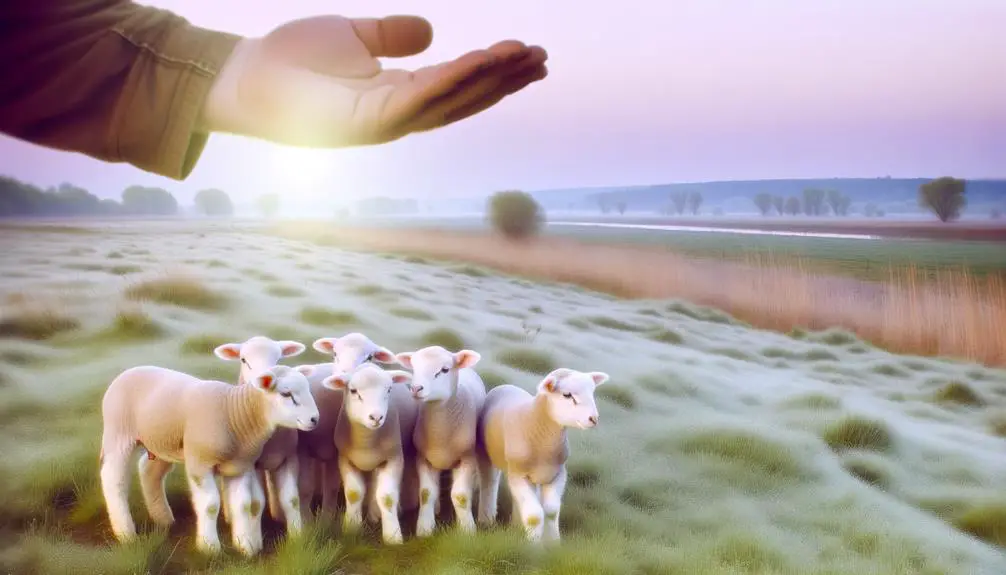Explore the profound symbolism of sheep in the Bible, embodying purity, obedience, and sacrifice—what deeper meanings lie beneath their gentle nature?

Characteristics of a Sheep in the Bible
In the Bible, you'll find that sheep hold deep symbolism, representing innocence, purity, and meekness. Their white wool symbolizes righteousness, a portrayal of a pure and peaceful life. Sheep also epitomize obedience and submission, embodying deep trust in their shepherd's guidance, akin to faith in divine leadership. Their role in sacrificial rites underlines their importance in atonement, prefiguring the "Lamb of God" as a messianic figure. Due to their natural follower instincts and dependence on the shepherd for protection, sheep highlight the values of guidance and leadership. Each characteristic opens up further layers of understanding in biblical texts.
Key Takeaways
- Sheep symbolize innocence and purity, often depicted in peaceful settings.
- They embody meekness, combining gentle assertiveness with humble strength.
- Sheep represent obedience and submission, showing trust in their shepherd's guidance.
- They are central to sacrificial rituals, symbolizing purity and atonement.
- Sheep exhibit natural follower instincts, relying on strong leadership and guidance.
Symbol of Innocence

In the Bible, a sheep often symbolizes innocence, reflecting the purity and guilelessness attributed to these creatures. You'll find that their gentle nature is not merely an incidental trait but a profound emblematic representation, woven deeply into the fabric of biblical narratives. This symbolism aligns with the peaceful imagery consistently used throughout scriptures, where sheep are depicted in serene pastures or beside still waters, evoking a sense of harmony and sanctity.
The depiction isn't just literal but also serves a metaphorical purpose, illustrating the relationship between the divine and humanity. Just as a shepherd leads his flock with care and attentiveness, so too are you led, if you follow the spiritual path laid out in the scriptures. This pastoral imagery, combined with the innocence of sheep, reinforces the message of trust and purity in divine guidance.
Analyzing these representations, you're invited to see yourself in this imagery—a soul guided by the supreme shepherd. The sheep's unassuming presence and its portrayal in calm environments are not merely for aesthetic appreciation but are imbued with theological significance, encouraging a life of peace and simplicity, free from guile.
Embodiment of Meekness
As you explore the concept of meekness, consider how it is intricately linked with biblical sheep symbolism. The Scriptures often depict sheep as models of humility and submission, qualities that are central to understanding meekness. This perspective will guide you through an analysis of how meekness manifests in biblical narratives and teachings.
Definition of Meekness
Meekness, often misunderstood, embodies a quiet strength that's deeply revered in biblical texts. As you explore further, you'll recognize it's not merely about being submissive, but rather it's a fusion of gentle assertiveness with humble strength. This nuanced trait allows you to navigate conflicts and challenges with grace and wisdom, without compromising your core values. It's about maintaining your integrity while being responsive, rather than reactive, to adversity.
Understanding meekness in this light, you see its power isn't in weakness but in controlled strength. It's a deliberate choice to be gentle when you could be harsh, to guide when you could dominate, embodying the profound spiritual discipline praised throughout scripture. This meekness isn't passive; it's a proactive stance of strength, clothed in humility.
Biblical Sheep Symbolism
Sheep in biblical texts often symbolize the very essence of meekness, serving as a vivid illustration of gentle, controlled strength. In the scriptures, their demeanor and interactions with their shepherd offer rich symbolism that you can explore to deepen your understanding of spiritual teachings.
- Shepherd Guidance: Sheep are led by the shepherd, symbolizing trust and obedience in divine guidance.
- Flock Behavior: Moving as a unit, sheep exemplify community and collective action under wise leadership.
- Quiet Strength: Their quietness is not weakness but a form of strength under control.
- Dependence on the Shepherd: This highlights their need for constant guidance and protection, mirroring human dependence on divine providence.
Reflect on these aspects to grasp the full depth of their symbolic significance in biblical narratives.
Meekness in Scriptures
Reflecting on the role of sheep in biblical narratives, it's clear that their characteristics powerfully embody the concept of meekness as portrayed in the scriptures. This gentle strength, inherent in their demeanor, provides a profound model for understanding how you might navigate your own spiritual journey. Sheep demonstrate quiet submission, not as a sign of weakness, but as a confirmation of their reliance on the shepherd's guidance and protection. This parallels the scriptural encouragement for you to submit to divine will, trusting in a higher power to lead and protect. Meekness, then, isn't about self-abasement but about recognizing where true strength is found. It's a call to humility and dependence on God, aligning your strength with His purposes.
Representation of Obedience
You've observed how sheep in the Bible embody meekness; now, let's turn your attention to their representation of obedience. Consider the scriptural sheep symbolism, which frequently aligns these creatures with followers of divine will, illustrating an unyielding adherence to spiritual guidance. By examining historical examples of obedience, you'll gain a deeper understanding of how this trait is not only depicted but valorized in biblical narratives.
Scriptural Sheep Symbolism
In biblical texts, sheep often symbolize obedience, exemplifying the virtues of submission and attentiveness to the shepherd's guidance. This representation is deeply rooted in pastoral imagery and flock dynamics, where each sheep's behavior reflects a larger spiritual narrative. Consider how this symbolism unfolds through scripture:
- Pastoral Imagery: Sheep graze in structured, serene environments, mirroring spiritual peace and community harmony.
- Flock Dynamics: The collective movement of the flock under the shepherd's direction emphasizes unity and collective faith.
- Shepherd's Role: As a guide, the shepherd's actions and decisions are pivotal, symbolizing divine leadership.
- Sheep's Response: Their following and responsiveness highlight a model of trust and faith in higher guidance.
This symbolism invites you to reflect on your own path of spiritual obedience and guidance.
Historical Obedience Examples
Building on the understanding of sheep as symbols of obedience, let's explore specific historical examples where this virtue is prominently displayed in biblical narratives. You'll find that shepherd interactions often highlight the obedience of sheep, serving as a profound metaphor for spiritual guidance and submission. Take, for example, the Psalmist's depiction where the shepherd leads, and the flock follows, demonstrating trust and compliance. This imagery isn't merely poetic; it's steeped in the cultural and historical practices of pastoral care.
Analyzing flock dynamics further, you'll see that sheep's reliance on their shepherd's direction underscores a model of collective obedience, essential for their survival and welfare. Such examples not only illuminate the text but also enrich your understanding of obedience as a spiritual principle.
Sacrificial Significance

Throughout biblical scripture, sheep hold a profound role as sacrificial animals, symbolizing purity and atonement. Their use in sacrifices is deeply embedded in the rituals and practices that define spiritual cleansing and reconciliation between humanity and the divine.
- Redemptive Role: Sheep were central in atonement rituals, where their lives were offered to amend for human sins, highlighting their role in the restoration of spiritual harmony.
- Day of Atonement: Annually, on Yom Kippur, a sheep's sacrifice was pivotal. Its blood, sprinkled in the Holy of Holies, was a potent symbol of sanctification and divine mercy.
- Passover Lamb: The sacrificial lamb during Passover vividly illustrated deliverance, its blood marking the Israelites' doors as a sign for the angel of death to pass over, sparing their firstborn.
- Prophetic Symbolism: The imagery of sheep as sacrifices foretold the coming of a messianic figure, portrayed as the "Lamb of God" who would take away the sins of the world through a self-sacrifice.
As you reflect on these aspects, you're drawn deeper into the intricate ways these practices shaped the spiritual landscape of the biblical world, embedding a rich tapestry of meaning and devotion in the humble figure of a sheep.
Follower Instincts
While exploring the sacrificial importance of sheep, it's also important to examine their natural follower instincts, which further illuminate their symbolic role in biblical narratives. You'll find that sheep's group behavior is emblematic of their need for guidance and structure. In a flock, each sheep tends to follow the others, often responding instinctively to the movements and actions dictated by a leader, whether another sheep or a shepherd.
This leadership response is not just a vital act but a deeply ingrained survival mechanism. It reflects a broader spiritual metaphor used throughout Scripture, where believers are encouraged to follow the teachings and path laid out by divine leadership. In observing sheep, you see a clear mirror of human congregational behavior, where individuals often look towards a leader for spiritual and moral guidance.
Moreover, this tendency to follow is not indicative of weakness but rather a confirmation of the strength found in community and unity. It's a poignant reminder of the value of trust and the comfort in guidance, both spiritually and practically. Therefore, the follower instincts of sheep profoundly resonate with biblical themes of discipleship and community.
Purity and Holiness

In biblical symbolism, sheep are often depicted as icons of purity and holiness, reflecting their role in ritual sacrifices and divine narratives. You, as a believer, might find that understanding these symbolic representations can enhance your perception of sanctified living and divine purity. Sheep, in their unblemished form, were required for sacrifices, signifying a high standard of purity that aligns with God's holiness. This imagery isn't merely historical; it's a call to purity in your own life.
Consider these aspects of how sheep symbolize purity and holiness:
- Unblemished Sacrifices: Sheep used in sacrifices were to be without defect, symbolizing the perfect holiness required to approach God.
- White Wool: Often associated with purity, their white fleece can remind you of the righteousness that believers are called to uphold.
- Passive Nature: Their gentle and docile behavior can be seen as a model for the peaceful and pure life that you're encouraged to lead.
- Association with Festivals: Sheep were central in many religious festivals, which underscores their role in purification rites and holy celebrations.
Reflecting on these connections between sheep, purity, and holiness might inspire you to pursue a deeper, more sanctified way of living that mirrors divine purity.
Guidance and Leadership
Sheep are frequently portrayed as followers in biblical narratives, emphasizing the need for effective guidance and strong leadership in spiritual journeys. In these stories, shepherd roles are not merely occupational; they are deeply symbolic, representing divine oversight and care. As you explore these texts, you'll notice that shepherds are tasked with not just the physical steering of the sheep but also their moral and spiritual guidance.
These shepherd figures often serve as directional metaphors. For instance, Psalm 23 encapsulates this beautifully, stating, 'The Lord is my shepherd; I shall not want. He maketh me to lie down in green pastures: he leadeth me beside the still waters.' Here, the leadership is both literal and figurative. The shepherd leads to nourishment and rest—essential for survival—but also guides along paths of righteousness, essential for spiritual well-being.
Understanding these roles enhances your comprehension of the broader biblical message concerning leadership and guidance. It's about more than direction; it's about leading with foresight, compassion, and a deep commitment to the welfare of others. As you reflect on these passages, consider how leadership in your life aligns with these biblical ideals, promoting not just goal achievement but holistic growth and nurturing.
Vulnerability and Dependence

Reflecting on the shepherd's role highlights not only their leadership but also the inherent vulnerability and dependence of sheep within these biblical narratives. As you explore further into these stories, you'll notice how sheep behavior underscores their need for constant guidance and protection. This reliance isn't just a facet of their physical makeup but a profound emblem of spiritual truths communicated through scripture.
In the biblical context, sheep do not possess the natural defenses that other creatures have. Their vulnerability is multifaceted, encompassing physical weakness and a behavioral inclination to follow, sometimes even to their peril. Here are some key aspects:
- Lack of natural defenses: Sheep are not equipped with the means to defend themselves effectively against predators.
- Herd mentality: Their tendency to move in flocks can prevent individual critical action, necessitating external guidance.
- Dependence on the shepherd: For food, water, and safety, sheep look to their shepherd.
- Need for constant supervision: Without watchful eyes, sheep easily wander and can fall into dangerous situations.
These characteristics necessitate robust protective strategies by the shepherd, embodying a deeper, spiritual vigilance that's echoed in pastoral care. You're invited to reflect on these dimensions, understanding how they illustrate broader spiritual dependencies.
Frequently Asked Questions
How Do Sheep Feature in Jesus' Parables?
In Jesus' parables, sheep often symbolize innocence and followership. Your understanding of parable interpretation enriches when you grasp this sheep symbolism, deepening insights into spiritual guidance and communal responsibilities highlighted in the narratives.
What Breeds of Sheep Are Mentioned in the Bible?
You'll find that specific sheep breeds aren't mentioned in the Bible; instead, it focuses on general characteristics rather than breed-specific traits or origins. This approach emphasizes broader spiritual lessons over biological details.
Are Sheep Metaphors Used by the Prophets?
Fascinatingly, just as you're exploring symbolic meanings, prophets in the Bible frequently used sheep as metaphors to offer deep, metaphorical guidance, embodying prophet symbolism that resonates through scholarly, analytical, and reverent biblical interpretations.
Do Sheep Have Roles in Biblical Festivals?
Yes, sheep play vital roles in Biblical festivals, primarily through sheep sacrifices. These acts embody deep festival symbolism, reflecting themes of atonement and renewal that you'll find central to these religious observances.
How Did Shepherds Communicate With Their Sheep?
Shepherds wielded their tools like artists, painting the air with vocal patterns to guide their flocks. These patterns, integral to shepherd tools, facilitated clear, effective communication, ensuring cohesion and safety within the flock.



Sign up